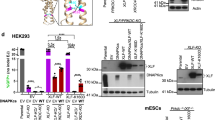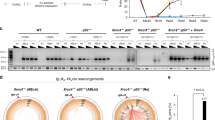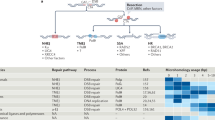Abstract
Here we have used an intrachromosomal substrate to monitor the end joining of distant ends, which leads to DNA rearrangements in mammalian cells. We show that silencing Mre11 reduces the efficiency of nonhomologous end joining (NHEJ), affecting both the canonical and alternative pathways, partly in a manner that is independent of the ataxia-telangiectasia mutated kinase (ATM). Silencing of Rad50 or CtIP decreases end-joining efficiency in the same pathway as Mre11. In cells defective for Xrcc4, the MRE11–RAD50–NBS1 (MRN) complex inhibitor MIRIN decreases end-joining frequencies, demonstrating a role for MRN in alternative NHEJ. Consistently, MIRIN sensitizes both complemented and NHEJ-defective cells to ionizing radiation. Conversely, overexpression of Mre11 stimulates the resection of single-stranded DNA and increases alternative end joining, through a mechanism that requires Mre11's nuclease activity, but in an ATM-independent manner. These data demonstrate that, in addition to its role in ATM activation, Mre11 can favor alternative NHEJ through its nuclease activity.
This is a preview of subscription content, access via your institution
Access options
Subscribe to this journal
Receive 12 print issues and online access
$189.00 per year
only $15.75 per issue
Buy this article
- Purchase on Springer Link
- Instant access to full article PDF
Prices may be subject to local taxes which are calculated during checkout






Similar content being viewed by others
References
Allen, C., Kurimasa, A., Brenneman, M.A., Chen, D.J. & Nickoloff, J.A. DNA-dependent protein kinase suppresses double-strand break-induced and spontaneous homologous recombination. Proc. Natl. Acad. Sci. USA 99, 3758–3763 (2002).
Delacôte, F., Han, M., Stamato, T.D., Jasin, M. & Lopez, B.S. An xrcc4 defect or Wortmannin stimulates homologous recombination specifically induced by double-strand breaks in mammalian cells. Nucleic Acids Res. 30, 3454–3463 (2002).
Pierce, A.J., Hu, P., Han, M., Ellis, N. & Jasin, M. Ku DNA end-binding protein modulates homologous repair of double-strand breaks in mammalian cells. Genes Dev. 15, 3237–3242 (2001).
Chen, J.M., Cooper, D.N., Chuzhanova, N., Ferec, C. & Patrinos, G.P. Gene conversion: mechanisms, evolution and human disease. Nat. Rev. Genet. 8, 762–775 (2007).
Purandare, S.M. & Patel, P.I. Recombination hot spots and human disease. Genome Res. 7, 773–786 (1997).
Guirouilh-Barbat, J. et al. Impact of the KU80 pathway on NHEJ-induced genome rearrangements in mammalian cells. Mol. Cell 14, 611–623 (2004).
Michel, B. et al. Rescue of arrested replication forks by homologous recombination. Proc. Natl. Acad. Sci. USA 98, 8181–8188 (2001).
Saintigny, Y. et al. Characterization of homologous recombination induced by replication inhibition in mammalian cells. EMBO J. 20, 3861–3870 (2001).
Couëdel, C. et al. Collaboration of homologous recombination and nonhomologous end-joining factors for the survival and integrity of mice and cells. Genes Dev 18, 1293–1304 (2004).
Mills, K.D. et al. Rad54 and DNA ligase IV cooperate to maintain mammalian chromatid stability. Genes Dev. 18, 1283–1292 (2004).
Bartkova, J. et al. DNA damage response as a candidate anti-cancer barrier in early human tumorigenesis. Nature 434, 864–870 (2005).
Gorgoulis, V.G. et al. Activation of the DNA damage checkpoint and genomic instability in human precancerous lesions. Nature 434, 907–913 (2005).
Audebert, M., Salles, B. & Calsou, P. Involvement of poly(ADP-ribose) polymerase-1 and XRCC1/DNA ligase III in an alternative route for DNA double-strand breaks rejoining. J. Biol. Chem. 279, 55117–55126 (2004).
Corneo, B. et al. Rag mutations reveal robust alternative end joining. Nature 449, 483–486 (2007).
Guirouilh-Barbat, J., Rass, E., Plo, I., Bertrand, P. & Lopez, B.S. Defects in XRCC4 and KU80 differentially affect the joining of distal nonhomologous ends. Proc. Natl. Acad. Sci. USA 104, 20902–20907 (2007).
McVey, M. & Lee, S.E. MMEJ repair of double-strand breaks (director's cut): deleted sequences and alternative endings. Trends Genet. 24, 529–538 (2008).
Soulas-Sprauel, P. et al. Role for DNA repair factor XRCC4 in immunoglobulin class switch recombination. J. Exp. Med. 204, 1717–1727 (2007).
Wang, H., Perrault, A.R., Takeda, Y., Qin, W. & Iliakis, G. Biochemical evidence for Ku-independent backup pathways of NHEJ. Nucleic Acids Res. 31, 5377–5388 (2003).
Yan, C.T. et al. IgH class switching and translocations use a robust non-classical end-joining pathway. Nature 449, 478–482 (2007).
Gao, Y. et al. Interplay of p53 and DNA-repair protein XRCC4 in tumorigenesis, genomic stability and development. Nature 404, 897–900 (2000).
Weinstock, D.M., Brunet, E. & Jasin, M. Formation of NHEJ-derived reciprocal chromosomal translocations does not require Ku70. Nat. Cell Biol. 9, 978–981 (2007).
Boulton, S.J. & Jackson, S.P. Components of the Ku-dependent non-homologous end-joining pathway are involved in telomeric length maintenance and telomeric silencing. EMBO J. 17, 1819–1828 (1998).
Moore, J.K. & Haber, J.E. Cell cycle and genetic requirements of two pathways of nonhomologous end-joining repair of double-strand breaks in Saccharomyces cerevisiae. Mol. Cell. Biol. 16, 2164–2173 (1996).
Zhang, X. & Paull, T.T. The Mre11/Rad50/Xrs2 complex and non-homologous end-joining of incompatible ends in S. cerevisiae. DNA Repair (Amst.) 4, 1281–1294 (2005).
Ma, J.L., Kim, E.M., Haber, J.E. & Lee, S.E. Yeast Mre11 and Rad1 proteins define a Ku-independent mechanism to repair double-strand breaks lacking overlapping end sequences. Mol. Cell. Biol. 23, 8820–8828 (2003).
Mimitou, E.P. & Symington, L.S. Sae2, Exo1 and Sgs1 collaborate in DNA double-strand break processing. Nature 455, 770–774 (2008).
Zhu, Z., Chung, W.H., Shim, E.Y., Lee, S.E. & Ira, G. Sgs1 helicase and two nucleases Dna2 and Exo1 resect DNA double-strand break ends. Cell 134, 981–994 (2008).
Lee, J.H. & Paull, T.T. Direct activation of the ATM protein kinase by the Mre11/Rad50/Nbs1 complex. Science 304, 93–96 (2004).
Di Virgilio, M. & Gautier, J. Repair of double-strand breaks by nonhomologous end joining in the absence of Mre11. J. Cell Biol. 171, 765–771 (2005).
Huang, J. & Dynan, W.S. Reconstitution of the mammalian DNA double-strand break end-joining reaction reveals a requirement for an Mre11/Rad50/NBS1-containing fraction. Nucleic Acids Res. 30, 667–674 (2002).
Deriano, L., Stracker, T.H., Baker, A., Petrini, J.H. & Roth, D.B. Roles for NBS1 in alternative nonhomologous end-joining of V(D)J recombination intermediates. Mol. Cell 34, 13–25 (2009).
Helmink, B.A. et al. MRN complex function in the repair of chromosomal Rag-mediated DNA double-strand breaks. J. Exp. Med. 206, 669–679 (2009).
de Jager, M. et al. Human Rad50/Mre11 is a flexible complex that can tether DNA ends. Mol. Cell 8, 1129–1135 (2001).
Buis, J. et al. Mre11 nuclease activity has essential roles in DNA repair and genomic stability distinct from ATM activation. Cell 135, 85–96 (2008).
Williams, R.S. et al. Mre11 dimers coordinate DNA end bridging and nuclease processing in double-strand-break repair. Cell 135, 97–109 (2008).
Ira, G. et al. DNA end resection, homologous recombination and DNA damage checkpoint activation require CDK1. Nature 431, 1011–1017 (2004).
Jazayeri, A. et al. ATM- and cell cycle-dependent regulation of ATR in response to DNA double-strand breaks. Nat. Cell Biol. 8, 37–45 (2006).
Chen, L., Nievera, C.J., Lee, A.Y. & Wu, X. Cell cycle-dependent complex formation of BRCA1.CtIP.MRN is important for DNA double-strand break repair. J. Biol. Chem. 283, 7713–7720 (2008).
Lee, K. & Lee, S.E. Saccharomyces cerevisiae Sae2- and Tel1-dependent single-strand DNA formation at DNA break promotes microhomology-mediated end joining. Genetics 176, 2003–2014 (2007).
Lengsfeld, B.M., Rattray, A.J., Bhaskara, V., Ghirlando, R. & Paull, T.T. Sae2 is an endonuclease that processes hairpin DNA cooperatively with the Mre11/Rad50/Xrs2 complex. Mol. Cell 28, 638–651 (2007).
Limbo, O. et al. Ctp1 is a cell-cycle-regulated protein that functions with Mre11 complex to control double-strand break repair by homologous recombination. Mol. Cell 28, 134–146 (2007).
Sartori, A.A. et al. Human CtIP promotes DNA end resection. Nature 450, 509–514 (2007).
Dupré, A. et al. A forward chemical genetic screen reveals an inhibitor of the Mre11-Rad50-Nbs1 complex. Nat. Chem. Biol. 4, 119–125 (2008).
Lee, J.H. & Paull, T.T. Activation and regulation of ATM kinase activity in response to DNA double-strand breaks. Oncogene 26, 7741–7748 (2007).
Farah, J.A., Cromie, G., Steiner, W.W. & Smith, G.R. A novel recombination pathway initiated by the Mre11/Rad50/Nbs1 complex eliminates palindromes during meiosis in Schizosaccharomyces pombe. Genetics 169, 1261–1274 (2005).
Neale, M.J., Pan, J. & Keeney, S. Endonucleolytic processing of covalent protein-linked DNA double-strand breaks. Nature 436, 1053–1057 (2005).
Paull, T.T. & Gellert, M. The 3′ to 5′ exonuclease activity of Mre 11 facilitates repair of DNA double-strand breaks. Mol. Cell 1, 969–979 (1998).
Hartsuiker, E. et al. Ctp1CtIP and the Rad32Mre11 nuclease activity are required for Rec12Spo11 removal but Rec12Spo11 removal is dispensable for other MRN-dependent meiotic functions. Mol. Cell Biol. 29, 1671–1681 (2009).
Dinkelmann, M. et al. Multiple functions of MRN in end-joining pathways during isotype class switching. Nat. Struct. Mol. Biol. advance online publication, doi:10.1038/nsmb.1639 (26 July 2009).
Deng, Y., Guo, X., Ferguson, D.O. & Chang, S. Multiple roles for Mre11 at uncapped telomeres. Nature advance online publication, doi:10.1038/naturexxx (26 July 2009).
Xie, A., Kwok, A. & Scully, R. Role of mammalian Mre11 in classical and alternative non-homologous end joining. Nat. Struct. Mol. Biol. advance online publication, doi:10.1038/nsmb.1640 (26 July 2009).
Haince, J.F. et al. PARP1-dependent kinetics of recruitment of MRE11 and NBS1 proteins to multiple DNA damage sites. J. Biol. Chem. 283, 1197–1208 (2008).
Wang, M. et al. PARP-1 and Ku compete for repair of DNA double strand breaks by distinct NHEJ pathways. Nucleic Acids Res. 34, 6170–6182 (2006).
Huertas, P., Cortes-Ledesma, F., Sartori, A.A., Aguilera, A. & Jackson, S.P. CDK targets Sae2 to control DNA-end resection and homologous recombination. Nature 455, 689–692 (2008).
Johnson, R.D. & Jasin, M. Sister chromatid gene conversion is a prominent double-strand break repair pathway in mammalian cells. EMBO J. 19, 3398–3407 (2000).
Saintigny, Y., Delacote, F., Boucher, D., Averbeck, D. & Lopez, B.S. XRCC4 in G1 suppresses homologous recombination in S/G2, in G1 checkpoint-defective cells. Oncogene 26, 2769–2780 (2007).
Paull, T.T., Cortez, D., Bowers, B., Elledge, S.J. & Gellert, M. Direct DNA binding by Brca1. Proc. Natl. Acad. Sci. USA 98, 6086–6091 (2001).
Baldeyron, C. et al. A single mutated BRCA1 allele leads to impaired fidelity of double strand break end-joining. Oncogene 21, 1401–1410 (2002).
Zhong, Q., Boyer, T.G., Chen, P.L. & Lee, W.H. Deficient nonhomologous end-joining activity in cell-free extracts from Brca1-null fibroblasts. Cancer Res. 62, 3966–3970 (2002).
Guirouilh-Barbat, J., Huck, S. & Lopez, B.S. S-phase progression stimulates both the mutagenic KU-independent pathway and mutagenic processing of KU-dependent intermediates, for nonhomologous end joining. Oncogene 27, 1726–1736 (2008).
Ausubel, F. et al. Current Protocols in Molecular Biology (John Wiley & Sons, Inc., Boston, 1999).
Liang, F., Han, M., Romanienko, P.J. & Jasin, M. Homology-directed repair is a major double-strand break repair pathway in mammalian cells. Proc. Natl. Acad. Sci. USA 95, 5172–5177 (1998).
Yu, X. & Chen, J. DNA damage-induced cell cycle checkpoint control requires CtIP, a phosphorylation-dependent binding partner of BRCA1 C-terminal domains. Mol. Cell. Biol. 24, 9478–9486 (2004).
Acknowledgements
We thank Y. Shiloh (Sackler School of Medecine, Tel Aviv University) for providing the wild-type and mutant MRE11 plasmids, M. Jasin (Memorial Sloan-Kettering Cancer Center) for donating the I-SceI expression vector and R. Baer (Columbia University Medical Center) for CtIP antibodies. We are grateful to R. Scully (Beth Israel Deaconess Medical Center) and D. Ferguson (University of Michigan Medical School) for sharing results and to S. Gangloff, V. Pennaneach (IRCM), Y. Canitrot and D. Trouche (Université Paul Sabatier) for helpful discussions. We apologize to authors that are not quoted in references, due to space limitations. Thanks to G. Palierne for efficient technical support. E.R. is supported by a fellowship from La Ligue Nationale contre le Cancer and A.G. is an IRTELIS laureate. This work was supported by grants from La Ligue Nationale contre le Cancer “Equipe labellisée LA LIGUE 2008”, Agence Nationale de la Recherche and Institut National du Cancer.
Author information
Authors and Affiliations
Contributions
E.R. and A.G. performed experiments, participated in the interpretations and in the manuscript preparation; I.P. started the first experiments; J.G. furnished the MIRIN and the conditions of use; P.B. conceived the experiments, participated in the experiments and in the manuscript preparation and interpretated the data; B.S.L. conceived and interpreted the experiments and wrote the manuscript.
Corresponding authors
Supplementary information
Supplementary Text and Figures
Supplementary Figures 1–7 (PDF 3626 kb)
Rights and permissions
About this article
Cite this article
Rass, E., Grabarz, A., Plo, I. et al. Role of Mre11 in chromosomal nonhomologous end joining in mammalian cells. Nat Struct Mol Biol 16, 819–824 (2009). https://doi.org/10.1038/nsmb.1641
Received:
Accepted:
Published:
Issue Date:
DOI: https://doi.org/10.1038/nsmb.1641
This article is cited by
-
The DNA damage response pathway regulates the expression of the immune checkpoint CD47
Communications Biology (2023)
-
BTApep-TAT peptide inhibits ADP-ribosylation of BORIS to induce DNA damage in cancer
Molecular Cancer (2022)
-
DNA damage alters EGFR signaling and reprograms cellular response via Mre-11
Scientific Reports (2022)
-
Mechanism of MRX inhibition by Rif2 at telomeres
Nature Communications (2021)
-
Chromosome instability induced by mutations in TAD anchors leads to tumors
Genome Instability & Disease (2021)



